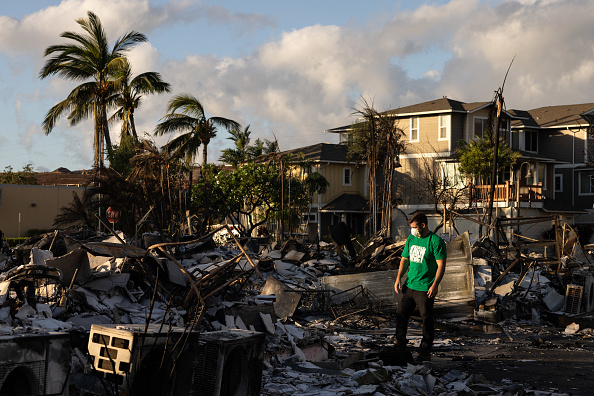On October 3, the official investigation report on the Maui wildfire in Hawaii last year, which resulted in at least 102 deaths, was released by the United States. The report revealed that the wildfire originated from a bush fire caused by fallen power lines, and firefighters mistakenly thought the fire had been extinguished and left the scene.
The deadliest wildfire in over a century in the United States broke out on August 8, 2023, engulfing the historic town of Lahaina due to strong and erratic winds, destroying thousands of buildings, trapping people in their cars, and forcing some residents to flee into the ocean.
According to the investigation report released by the Bureau of Alcohol, Tobacco, Firearms and Explosives (ATF) and the Maui Fire Department, the wildfire was apparently a reignition of the morning fire. It was suggested that strong winds may have blown undetected embers into nearby dry, grassy gullies, causing the fire to flare up again.
The responsibility for the wildfire primarily implicates two entities, the Hawaiian Electric Company and the Maui government and fire department.
The Hawaiian Electric Company expressed regret in a statement on Wednesday, acknowledging that their operations led to the ignition of the morning fire. They highlighted that their employees worked diligently in the face of extreme weather conditions and chaos.
ATF emphasized that Maui firefighters had done all they could to extinguish the morning fire before leaving the scene to attend to other service calls, as there were multiple fires burning on the island that day.
The ATF report indicated that while wind was the most likely cause of the fire’s reignition, investigators could not rule out another possibility. It suggested that a bulldozer operator trying to help contain the flames may have inadvertently pushed smoldering debris into a gully, leading to the fire reigniting hours later.
The report mentioned that the newly cut firebreak was very close to the edge of the gully, leaving room for the possibility that the operator might have unintentionally moved burning vegetation or smoldering debris into the gully while cutting the firebreak.
The owner of the bulldozer, who was asked to help by a friend living nearby, provided information to ATF without disclosing his identity or the identity of his team members. The onboard camera of the bulldozer captured loose soil and burnt vegetation piled on the edge of the gully.
However, the report did not delve into the issue of accountability for the wildfire.
The ATF report was included as an appendix in a report by the Maui Fire Department, which had requested the agency’s assistance in determining the cause of the fire last year. Several other agencies have also conducted investigations into the fire and its response, detailing the dire circumstances that led to the tragic outcome, including errors by the emergency services.
Communication challenges between the police and fire departments, along with paralyzed cellphone networks, hindered emergency officials from issuing evacuation alerts and residents from escaping.
Emergency responders struggled to get a clear answer from Hawaiian Electric Company representatives on whether power in the area had been cut off.
Many areas in the city experienced collapsed power lines and poles, prompting road closures by the police to protect residents from potentially hazardous wires. However, the blocked roads led to traffic jams, trapping evacuees in their cars as the flames approached. Some individuals perished at home or outdoors while attempting to flee.
Thousands of Lahaina residents have filed lawsuits against various parties they deem responsible for the fire, including the Hawaiian Electric Company, Maui County, and the state of Hawaii.
The defendants have been shifting blame onto each other. The Hawaiian Electric Company argued that the county should not have allowed firefighters to leave the scene before ensuring the initial fire was completely extinguished, while Maui County believes that the electric company failed to properly manage the power grid. The responsibility for clearing shrubs and maintaining the area has also become a point of contention among the defendants. Additionally, the lack of a public safety power shutoff plan by the electric company has drawn criticism.
In August of this year, on the first anniversary of the wildfire, Hawaii Governor Josh Green announced a $4 billion settlement agreement. The defendants agreed to pay the settlement amount to resolve claims, including the Hawaiian Electric Company, the state government, Maui County, major landowners, and other entities.
The agreement is currently on hold in court, awaiting a ruling from the Hawaii Supreme Court on whether insurance companies can individually pursue the defendants to recover the payments made to policyholders.
However, lawyers representing the victims in seeking compensation are concerned that allowing insurance companies to sue the Hawaiian Electric Company and other relevant parties would jeopardize the settlement agreement, deplete funds available to pay wildfire victims, and prolong litigation.
Jake Lowenthal, a lawyer representing the victims, expressed that the recently released investigation report did not provide any new information that would alter their liability theories in the case: firefighters left the scene, the utility company failed to maintain equipment or implement power shutoff plans, and some major landowners left their properties unattended, with dry, overgrown grass providing ample fuel for the fire.
(Reference: Associated Press)

